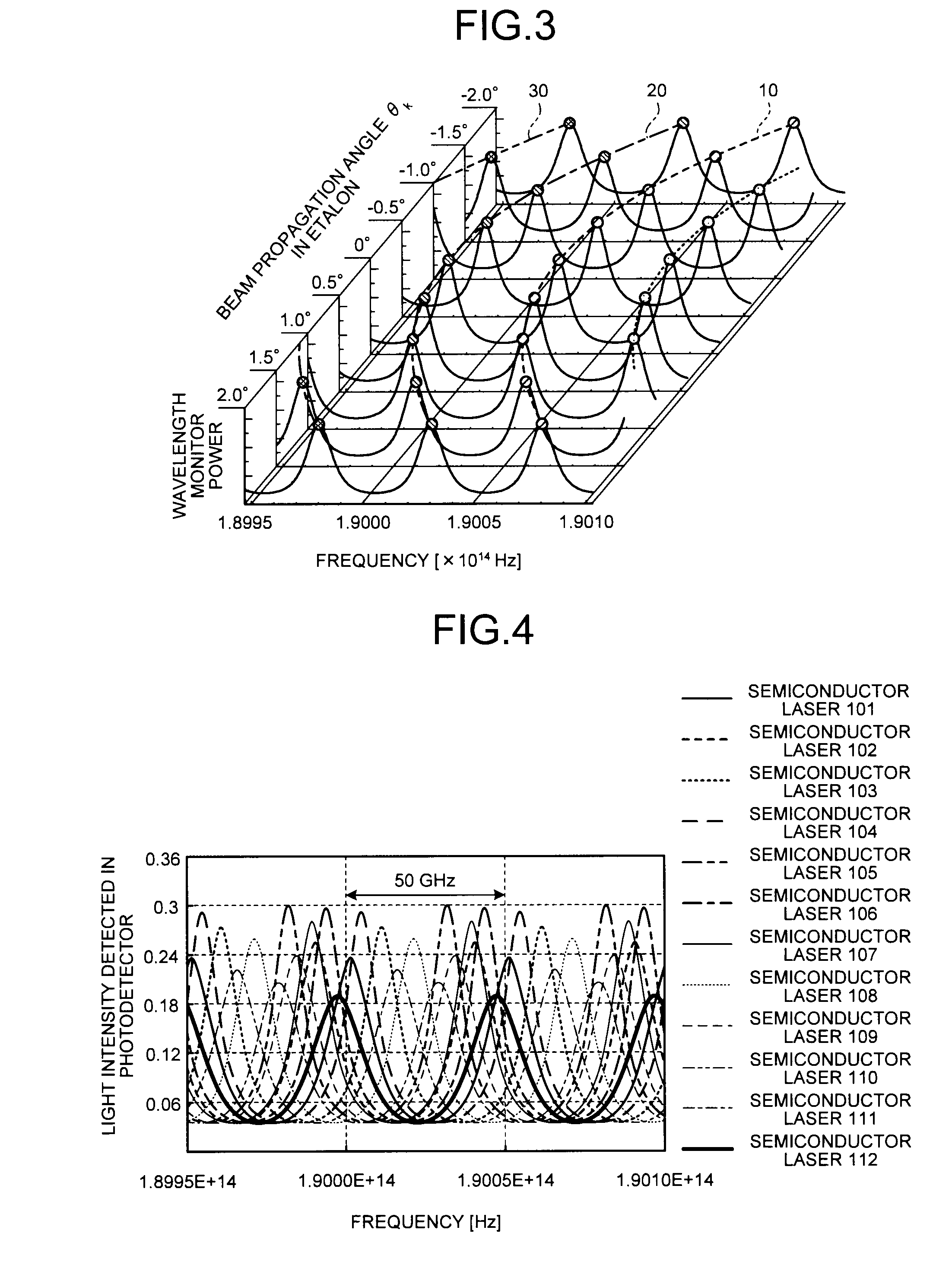Wavelength monitor
a monitor and wavelength technology, applied in the field of wavelength monitors, can solve the problems of increasing maintenance costs, increasing the size of the whole wavelength-variable light source, and increasing costs
- Summary
- Abstract
- Description
- Claims
- Application Information
AI Technical Summary
Benefits of technology
Problems solved by technology
Method used
Image
Examples
first embodiment
[0023]FIG. 1 is a diagram illustrating a configuration of a wavelength monitor according to the first embodiment of the present invention. The wavelength monitor according to the present embodiment is provided in a wavelength-variable optical module (not shown) capable of changing the wavelength of exit light, and includes a semiconductor substrate 1, two or more semiconductor lasers 101 to 112 formed in parallel on the semiconductor substrate 1, a collimating lens 2 that collimates diffusion light emitted from the semiconductor lasers 101 to 112 into parallel light, a filter (for example, an etalon 3) that is arranged in the backward of the semiconductor substrate 1 so that collimated light transmitted through the collimating lens 2 enters and has a periodic frequency dependence of the transmittance, and a photodetector 4 that receives light transmitted through the etalon 3 and detects the light intensity thereof.
[0024]In FIG. 1, as one example, a beam path 51 of a beam emitted fro...
second embodiment
[0047]FIG. 6 is a diagram illustrating a configuration of a wavelength monitor according to the second embodiment of the present invention. The wavelength monitor shown in FIG. 6 includes the semiconductor substrate 1, two or more semiconductor lasers 101 to 112 formed in parallel on the semiconductor substrate 1, optical waveguides 121 to 132 that function to confine light in a small area and guide the light in a specific direction, the collimating lens 2 that collimates diffused light emitted from the optical waveguides 121 to 132 into parallel light, a filter, for example, the etalon 3, which is arranged in the backward direction of the semiconductor substrate 1 so that the collimated light transmitted through the collimating lens 2 enters and has a periodic frequency dependence of the transmittance, and the photodetector 4 that receives the light transmitted through the etalon 3 and detects the light intensity. The optical waveguides 121 to 132 are arranged such that the positio...
third embodiment
[0051]FIG. 7 is a diagram illustrating a configuration of a wavelength monitor according to the third embodiment of the present invention. The present embodiment is a modified example of the first and second embodiments, wherein the wavelength monitor includes the semiconductor substrate 1, two or more semiconductor lasers 101 to 112 formed in parallel on the semiconductor substrate 1, the optical waveguides 121 to 132 (not shown, as can be optional and have the same structure as those shown in FIG. 6) that function to confine light beam in a small area and guide the light in a specific direction, the collimating lens 2 that collimates diffused light emitted from the optical waveguides 121 to 132 into parallel light, a filter, for example, the etalon 3, which is arranged in the backward direction of the semiconductor substrate 1 so that the collimated light transmitted through the collimating lens 2 enters and has a periodic frequency dependence of the transmittance, the photodetect...
PUM
 Login to View More
Login to View More Abstract
Description
Claims
Application Information
 Login to View More
Login to View More - R&D
- Intellectual Property
- Life Sciences
- Materials
- Tech Scout
- Unparalleled Data Quality
- Higher Quality Content
- 60% Fewer Hallucinations
Browse by: Latest US Patents, China's latest patents, Technical Efficacy Thesaurus, Application Domain, Technology Topic, Popular Technical Reports.
© 2025 PatSnap. All rights reserved.Legal|Privacy policy|Modern Slavery Act Transparency Statement|Sitemap|About US| Contact US: help@patsnap.com



